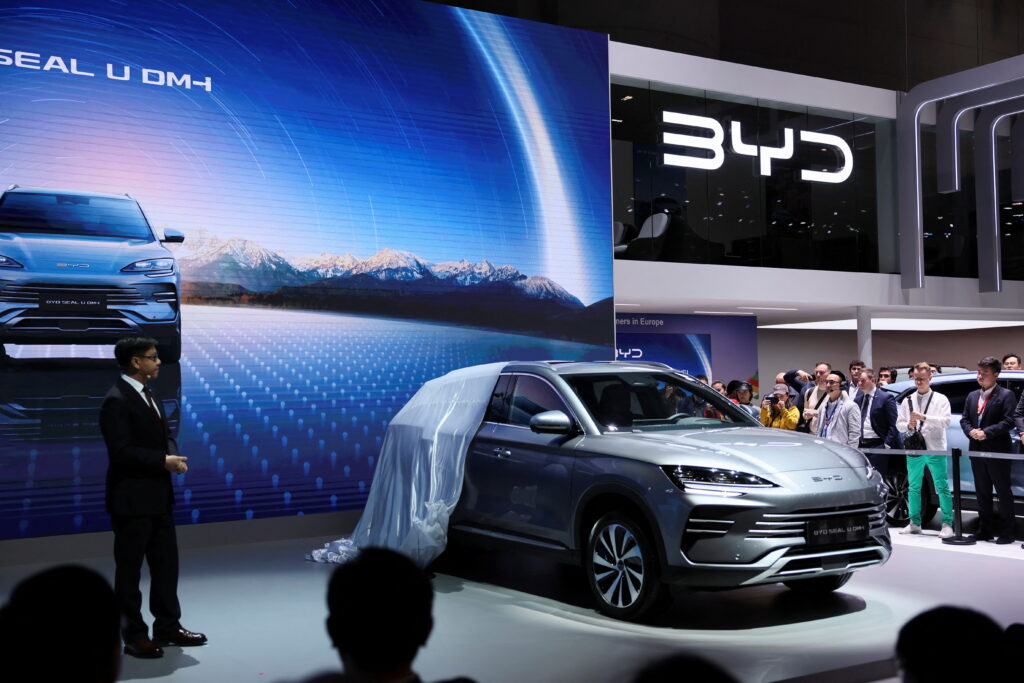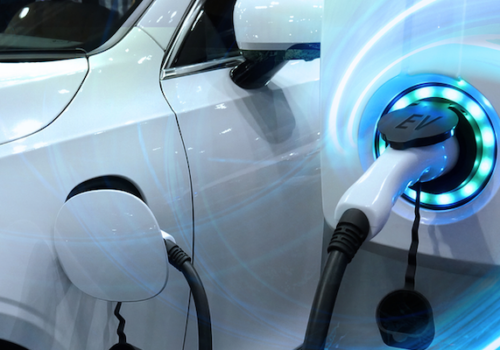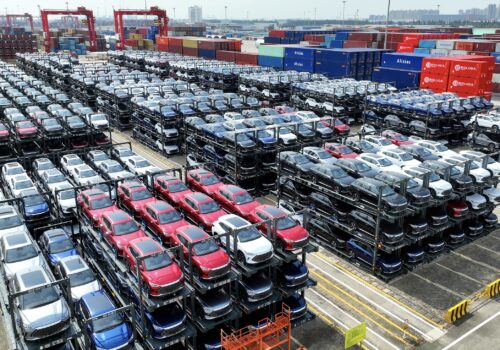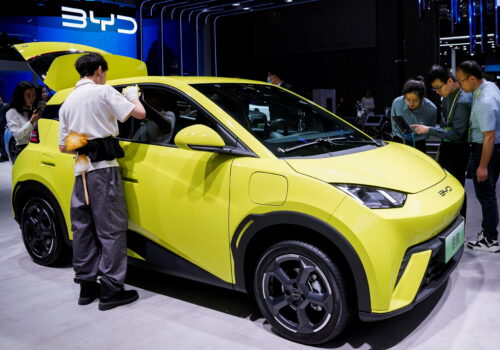European Union (EU) member states voted in favor today of allowing the European Commission to increase tariffs by up to 35.3 percent on Chinese battery electric vehicles (BEVs). The new levies are expected to go into effect by October 31. Although this decision signals growing alignment with the United States, there are important contextual differences that make transatlantic coordination on China’s economic practices even more essential.
How Washington and Brussels differ
The United States and EU have approached this issue from very different starting points. Unlike the EU, the United States navigated this process more smoothly since the measures were preemptive. The United States had little prior exposure to Chinese BEV imports or US BEV exports to China, making its decisions easier.
In May, the Biden administration announced a swath of tariffs on Chinese products in strategic sectors, including an increase of the tariff rate on Chinese BEVs from 25 percent to 100 percent under Section 301 of the Trade Act of 1974. The administration argued that the Chinese government’s subsidies in that industry contribute to unfair, nonmarket practices that would threaten the US auto industry and American jobs. Canada followed suit a few months later, announcing an increase from a tariff rate of 6.1 percent to 100 percent on Chinese BEV imports. And more recently, in late September, the US Commerce Department proposed rules that would “prohibit the sale or import of connected vehicles that incorporate certain technology and the import of particular components themselves from countries of concern, specifically the People’s Republic of China (PRC) and Russia” due to national security concerns.
While the United States has already moved on from tariffs to the national security issues surrounding connected vehicles, the EU understandably moved at a slower pace. This is due to the differing priorities of its member states, many of which are already significantly exposed to China in this sector. European Commission President Ursula von der Leyen announced the launch of the official European Commission investigation a year ago, stating that the EU’s leadership and innovation in the BEV sector “are being impeded by market distortions and unfair competition” by China. However, the need for approval by member states made the EU’s decision on this issue more fraught, which led to the emergence of two main factions. One group, led by von der Leyen and French President Emmanuel Macron, advocated for strengthening the tariffs to address market distortions. The other, led primarily by German Chancellor Olaf Scholz and supported by the German auto industry, had been Beijing’s ally on the inside, opposing these measures, largely due to enormous overexposure to Chinese markets. Unlike the United States’ situation, the results of the October 4 vote should also not be taken to mean that EU countries supporting the tariffs, such as France and Italy, are entirely against growing their engagement with China on BEVs.
China’s campaign to divide the EU
In recent months, China carried out a campaign aimed at dividing the EU on this issue ahead of the October 4 vote. Beijing ramped up these efforts further after the bloc set its provisional tariff rates in July, which were slightly reduced in August following a comment period. China’s campaign included leader-level outreach from Xi Jinping, as well as talks led by Minister of Commerce Wang Wentao and Minister of Foreign Affairs Wang Yi. Wang Wentao’s EU-level negotiations, combined with efforts from Scholz, showed some initial progress with the postponement of the final vote from September 25 to October 4. This postponement followed Wang Wentao’s meeting with European Commission Executive Vice-President Valdis Dombrovskis on September 19, which gave China a final opportunity to provide an attractive enough deal for the EU to mitigate the tariffs or end the inquiry altogether before the vote. Although the new vote date moved forward as scheduled, the European Commission has left the door open for continued negotiations with China even after the tariffs go into effect at the end of this month.
The most public tactic Beijing wielded was threatening trade retaliation targeting specific EU member states in key EU export sectors, including pork, brandy, and dairy. France, a major exporter of all three, was clearly being targeted as the primary instigator of the tariff policy in Beijing’s eyes. Spain, the key target for pork, flipped its position right after Spanish Prime Minister Pedro Sánchez met with Xi in Beijing on September 9, and it ultimately voted to abstain today, a shift from its informal, nonbinding ‘yes’ vote on July 15. However, other key pork exporters, such as the Netherlands and Denmark, maintained their support for the tariffs. Ireland, a major dairy exporter to China, changed to vote in favor of the tariffs today*, according to a report from Reuters, after abstaining from the previous informal, nonbinding vote in July. Ten other EU countries remained on the fence as well during the nonbinding vote, while only four (Slovakia, Hungary, Cyprus, and Malta) voted against the tariffs. Although Germany initially abstained from the July vote due to domestic pressure and to allow the process to move forward, Scholz wielded executive power to force a no vote for Germany today.
China has also offered carrots in the form of investment opportunities, such as offering to establish electric vehicle manufacturing plants in parts of Europe or forging joint development agreements between European and Chinese automakers. For instance, Beijing offered to invest in Spain’s local manufacturing capacity. Although reportedly delayed until October 2025, Chinese BEV producer Chery Auto plans to establish a manufacturing plant in Barcelona, which could potentially allow the company to circumvent the roughly 21 percent tariff rate it is currently facing. Hungary, which voted against the tariffs, will reportedly have an operational BYD manufacturing plant in 2025. Italy, though it voted in favor of the tariffs, is in talks with Dongfeng and Chery Auto for a manufacturing plant. Poland, which also voted in favor, has likely helped China avoid the tariffs by allowing Leapmotor International, a joint venture between Stellantis and Leapmotor, to begin manufacturing in the country as of this past June. And perhaps most surprisingly, Polestar, which is owned by Geely Holding and Geely-owned Volvo Cars, launched a manufacturing plant in South Carolina this past August, which could allow it to avoid some (though not necessarily all) of the US and EU tariffs.
Looking forward
To the European Commission’s credit, the current tariff episode marks a notable shift in the EU’s readiness to push back against Chinese pressure, especially when compared to past antidumping and subsidy cases involving solar energy and 5G infrastructure. However, the passage of the tariffs does not mark the end of this saga, as Beijing’s push to scale the manufacturing capacity of BEVs in Europe will likely blunt their effectiveness over time and further entrench itself within European markets. Further, even with some Chinese BEV companies such as Geely feeling the full impact of the tariffs, evidence indicates that they are unlikely to be high enough to significantly slow China’s market share gains. Beijing’s efforts, compounded by German efforts to protect the short-term interests of its auto industry, have successfully reduced the severity of the tariffs, allowed for continued opportunities for greenfield investments that could bypass them entirely, and opened the door to a potential negotiated compromise even after the tariffs are imposed, possibly involving a minimum import price or volume cap.
The EU tariffs will not fully block Chinese-made BEVs, and Beijing will likely still have the opportunity to establish a solid foothold on the continent. This is a key distinction between the United States and EU on this issue. Whereas the imposition of tariffs was largely security-driven in the United States, the EU tariffs were fundamentally trade-driven. As a result, Europe will now have to increasingly grapple with the national security impacts of vehicles equipped with cameras and other connected surveillance and software under China’s control. Further, the United States will continue to weigh in by raising data security risks associated with the increasing presence of Chinese BEVs in the EU, underscoring this issue by restricting Chinese-developed software in connected vehicles. Discussions on the security risks associated with connected vehicles, led by the United States, alongside the EU and other allies, are still in their infancy. The first Multinational Meeting to Address Connected Vehicle Risks was only just held in late July.
The United States must remain focused on uniting allies and partners to address challenges posed by China while acknowledging their agency. While Washington should continue to stress that tariffs alone are insufficient to address the broader risks posed by BEVs in the EU, it needs to recognize that the EU has unique interests and must address internal divisions in its own way. The United States also cannot expect allies and partners to blindly follow when its own strategy for derisking its relationship with China remains unclear.
Matt Geraci is an associate director of the Atlantic Council’s Global China Hub.
Correction: A previous version of this article misstated Ireland’s position on the EV tariffs. It voted in favor, according to a report in Reuters.
Further reading
Mon, Sep 9, 2024
Sharing the post carbon economy means building a resilient EV supply chain
Report By Sarah Bauerle Danzman
In this report Sarah Bauerle Danzman advances the policy discussion by compiling trade, investment, and EV industrial policy data across the G20, and offers six recommendations to the G20 to build a resilient EV supply chain.
Wed, Jun 12, 2024
Europe is gearing up to hit Chinese EVs with new tariffs. Here’s why.
New Atlanticist By
The European Commission just proposed new tariffs on China-made electric vehicles of up to 38 percent. Atlantic Council experts explain why—and what might happen next.
Tue, May 14, 2024
What to know about Biden’s new tariffs on Chinese EVs, solar cells, and more
New Atlanticist By
The Biden administration has imposed new tariffs on imports from China across a range of strategic industries. Atlantic Council experts dig into the details.
Image: Michael Shu, Managing Director of BYD Europe, stands next to the BYD SEAL U car, during the media day of the 91st Geneva Auto Show, in Geneva, Switzerland, February 26, 2024. REUTERS/Denis Balibouse



